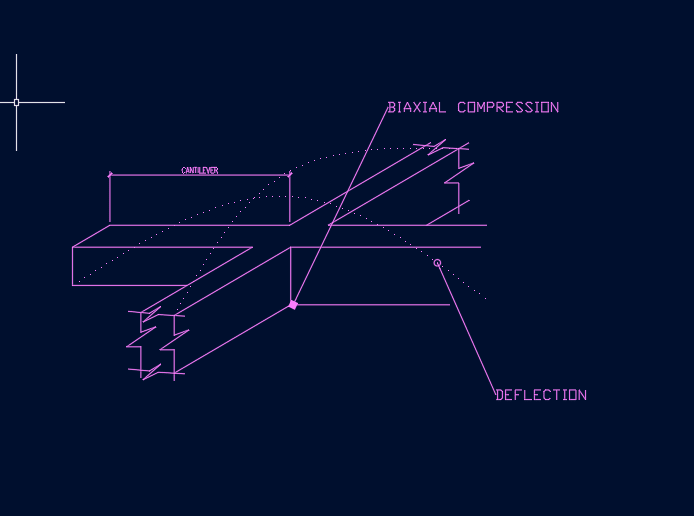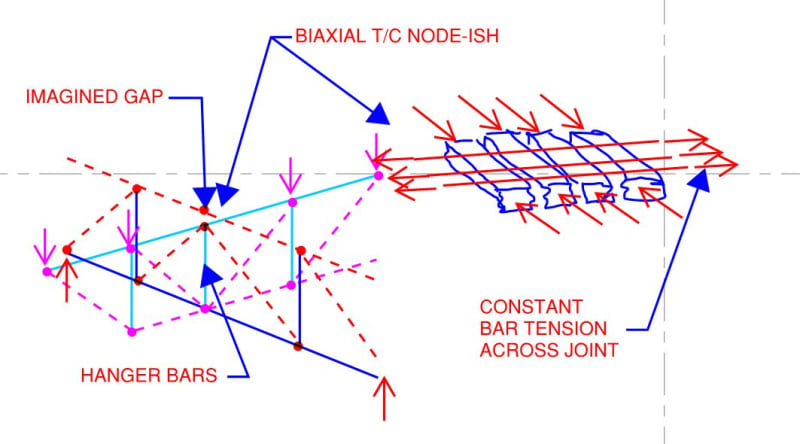Well, with your 3D strut and tie example, you've got me wondering on some things.
Agent666 said:
I think the same tension through the nodal zone from the supporting beam I have been talking about is load of rubbish on further reflection, because in effect you have these two intersecting 'beam' trusses, they share the same vertical tie/strut at the point of overlap.
Yes and no. Obviously, the girder stirrups and the cant beam hanger steel occupy the same physical space. That said, they don't share function really. In my mind, the hanger steel is used up in the act of of hanging and is not part of the shear truss model of the girder. Our biaxial stuff excepted, once the supported beam is "hung" it's almost as though it were now mounted
above the girder.
Agent666 said:
I was somehow trying to explain away there being no impact on the other direction by passing reinforcement through without change in tension, but this is impossible in a valid model of the OP's scenario... eureka moment?!
I'm not so sure. I really do not see the top steel tension in the supported beam changing appreciably as it crosses the joint. I see that STM looking like a flat bottomed vee tied across the top. Are you seeing that differently?
Coming back to your earlier work...
Preliminary:
When a tie crosses a strut
not at a node, I personally feel that there should be some reduction applied to the strut capacity. Sometimes, after all, we take active measures to confine our struts. So it's hard for me to imagine that struts are not weakened by the introduction of a crossing tension field.
A Reformulation of Your Argument (Maybe):
1) Codes have you apply a strut capacity reduction when tension ties cross at a node.
2) Codes do
not have you apply a strut capacity reduction when tension ties cross away from nodes.
3) What is one obvious difference between #1 & #2? At a node, the tie tension is changing across the strut. At a non-node, the tie tension is
not changing across the strut. This is sort of by definition as, in an STM, bar tension can only
be changed at a node. So perhaps you don't
actually have a node from the perspective of the tie unless the tie force is changed at the node.
4) 1 + 2 + 3 --> if tie tension isn't changing, it's not a node. Or, at the least, it's not a node that the tie is meaningfully participating in.
This is me trying to think like you. What do you think of that? This still doesn't say much about
why changing bar tension should be the thing that matters but it is, at least, circumstantial evidence that it may in fact
be the thing that matters.
You're right, of course, in that the 3D STM here makes the top of the joint a "node" because the hanger steel and two girder struts meet there. But it may
not be a node from the perspective of the cant beam top steel because no axial force is imparted to the top steel at the joint. Pass through.
Agent666 said:
My feelings on this are related to the cleat business in the other thread. I believe the following to be true:
1) Our field is, out of practical necessity, reactive and not proactive. To the uninitiated it appears that we know of all the possible failure modes, evaluate them, and then take a coffee break to celebrate a job well done. In reality, we know of only the failure modes that have previously plagued us, design for those alone, and cross our fingers that other terrible, unforeseen failure modes will not occur.
2) We suck at first principles connection design. Via Northridge, steel cleats, and the rest we seem to perpetually have egg on our collective faces in this realm. It's frankly hard to look at the situation objectively and avoid the conclusion that no connection should be allowed unless it's been vetted through testing.
There's an adage out there to the tune of:
Any bozo can design a member. It takes an engineer to design a connection.
That should be revised to:
Any engineer can design a member. It takes a federally funded research program and/or a sprinkling of pixie dust to design a connection.
HELP! I'd like your help with a thread that I was forced to move to the business issues section where it will surely be seen by next to nobody that matters to me:




